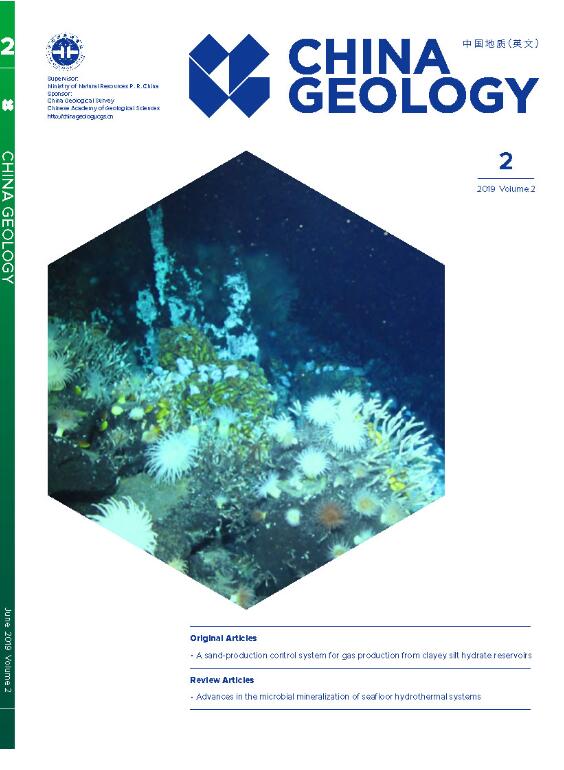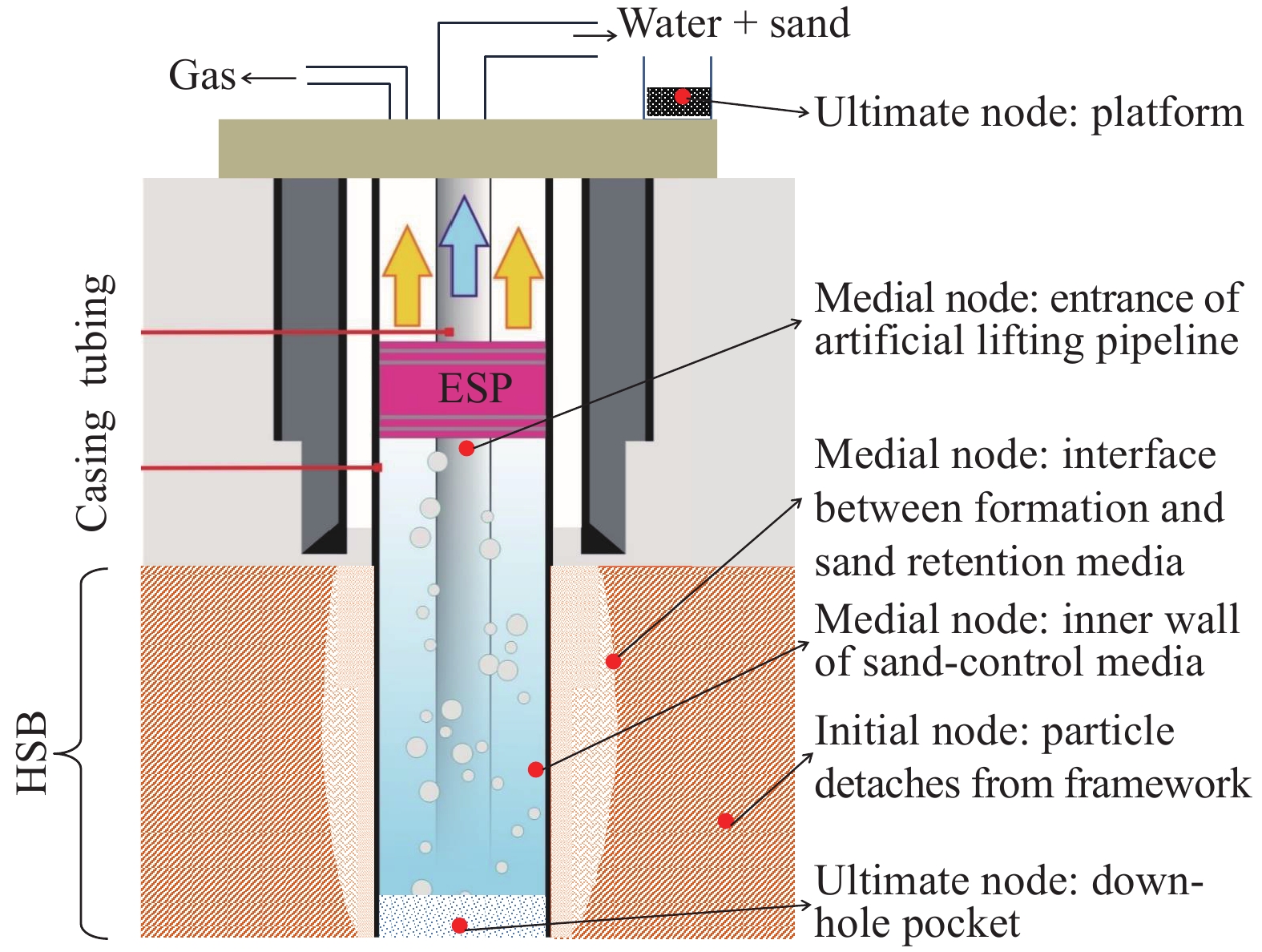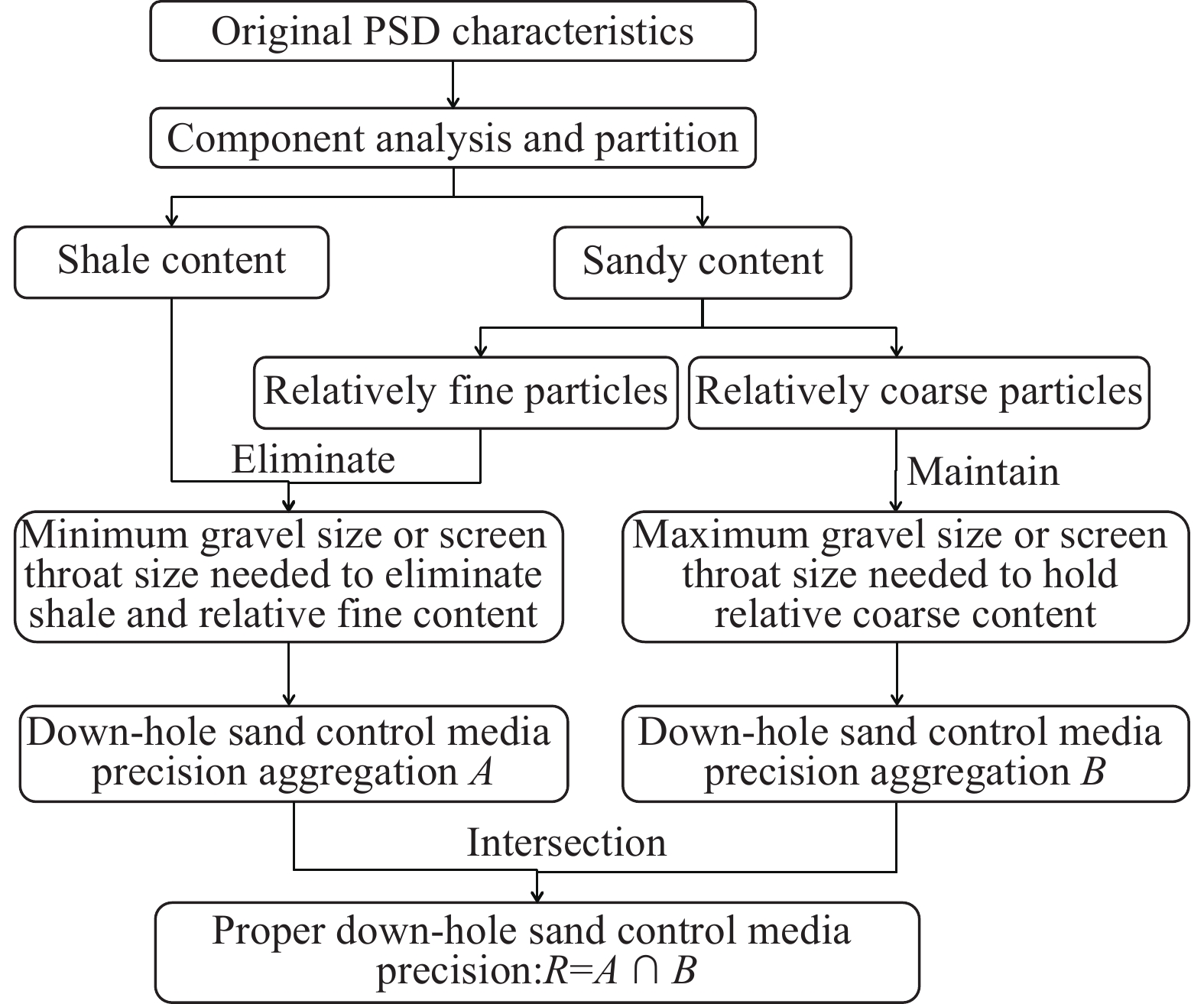| Citation: | Yan-long Li, Neng-you Wu, Fu-long Ning, Gao-wei Hu, Chang-ling Liu, Chang-yin Dong, Jing-an Lu, 2019. A sand-production control system for gas production from clayey silt hydrate reservoirs, China Geology, 2, 121-132. doi: 10.31035/cg2018081 |
A sand-production control system for gas production from clayey silt hydrate reservoirs
-
Abstract
Sand production is a crucial problem during the process of extracting natural gas from hydrate reservoirs. To deal with sand-production problems systematically, a sand-production control system (SCS) is first proposed in this paper, specialized for pore-distributed clayey silt hydrate reservoirs. Secondly, a nodal system analysis method (NSAM) is applied to analyze the sand migration process during hydrate exploitation. The SCS is divided into three sub-systems, according to different sand migration mechanisms, and three key scientific problems and advances in SCS research in China Geological Survey are reviewed and analyzed. The maximum formation sanding rate, proper sand-control gravel size, and borehole blockage risk position were provided for clayey hydrate exploitation wells based on the SCS analysis. The SCS sub-systems are closely connected via bilateral coupling, and coordination of the sub-systems is the basis of maintaining formation stability and prolonging the gas production cycle. Therefore, contradictory mitigation measures between sand production and operational systems should be considered preferentially. Some novel and efficient hydrate exploitation methods are needed to completely solve the contradictions caused by sand production.
-

-
References
[1] Anre. 2017. Second offshore methane hydrate-production test finishes. Agency for Natural Resource and Energy: Ministry of Economy, Trade and Industry News Release. [2] Boswell R, Collett T. 2011. Current perspectives on gas hydrate resources. Energy Environmental Science, 4, 1206–1215. doi: 10.1039/C0EE00203H [3] Boswell R, Schoderbek D, Collett TS, Ohtsuki S, White M, Anderson B. 2016a. The Iġnik Sikumi field experiment, Alaska north slope: design, operations, and implications for CO2-CH4 exchange in gas hydrate reservoirs. Energy & Fuels, 31(1), 140–153. [4] Boswell R, Shipp C, Reichel T, Shelander D, Saeki T, Frye M, Shedd W, Collett T, McConnell D R. 2016b. Prospecting for marine gas hydrate resources. Interpretation, 4(1), SA13–SA24. doi: 10.1190/INT-2015-0036.1 [5] Castaldi MJ, Zhou Y, Yegulalp TM. 2007. Down-hole combustion method for gas production from methane hydrates. Journal of Petroleum Science and Engineering, 56, 176–85. doi: 10.1016/j.petrol.2006.03.031 [6] Chen L, Sasaki H, Watanabe T, Okajima J, Komiya A, Maruyama S. 2017. Production strategy for oceanic methane hydrate extraction and power generation with Carbon Capture and Storage (CCS). Energy, 126, 256–272. doi: 10.1016/j.energy.2017.03.029 [7] Cheng Z, Mou X, Zhang J, Zhang L, Huang XL, Cheng K. 2014. Completion operation practice of deep-water gas wells in the eastern South China Sea. Oil Drilling & Production Technology, 36(3), 33–38. [8] Chong ZR, Yang SHB, Babu P, Linga P, Li XS. 2016. Review of natural gas hydrates as an energy resource, Prospects and challenges. Applied Energy, 162, 1633–1652. doi: 10.1016/j.apenergy.2014.12.061 [9] Chong ZR, Zhao JF, Chan JHR, Yin ZY, Linga P. 2018. Effect of horizontal wellbore on the production behavior from marine hydrate bearing sediment. Applied Energy, 214, 117–130. doi: 10.1016/j.apenergy.2018.01.072 [10] Collett T, Boswell R, Cochran JR, Kumar P, Lall M, Mazumdar A, Ramana MV, Ramprasad T, Riedel M, Sain K, Sathe AV, Vishwanath K, NGHP Expedition 01 Scientific Party. 2014. Geologic implications of gas hydrates in the offshore of India, results of the national gas hydrate program expedition 01. Marine & Petroleum Geology, 2014, 58(4), 3-28. [11] Collett T. 2002. Energy resource potential of natural gas hydrates. AAPG Bulletin, 86(11), 1971–1992. [12] Collett T, Bahk JJ, Frye M, Goldberg D, Husebo J, Koh C, Malone M, Shipp C, Torres M. Historical methane hydrate project review. 2013. Report, Consortium for Ocean Leadership. [13] Dallimore SR, Collett T. 2005. Scientific results from the Mallik 2002 gas hydrate production research well program, Mackenzie delta, northwest territories, Canada. Bulletin of the Geological Survey of Canada, 585. [14] Daraboina N, Pachitsas S, Solms NV. 2015. Experimental validation of kinetic inhibitor strength on natural gas hydrate nucleation. Fuel, 139(1), 554–560. [15] Demirbas A. 2010. Methane hydrates as potential energy resource, part 1-importance, resource and recovery facilities. Energy Conversion and Management, 51, 1547–1561. doi: 10.1016/j.enconman.2010.02.013 [16] Feng JC, Wang Y, Li XS, Chen ZY, Li G, Zhang Y. 2015. Investigation into optimization condition of thermal stimulation for hydrate dissociation in the sandy reservoir. Applied Energy, 154, 995–1003. doi: 10.1016/j.apenergy.2015.05.106 [17] Feng JC, Wang Y, Li XS. 2018. Dissociation characteristics of water-saturated methane hydrate induced by huff and puff method. Applied Energy, 211, 1171–1178. doi: 10.1016/j.apenergy.2017.12.004 [18] Guo XY, Liu F. 2017. China announced combustible ice test success in the Shenhu area, South China Sea. http,//china.cnr.cn/xwwgf/20170518/t20170518_523762235.shtml. [19] Haligva C, Linga P, Ripmeester JA, Englezos P. 2010. Recovery of methane from a variable volume bed of silica sand/hydrate by depressurization. Energy Fuels, 24, 2947–2955. doi: 10.1021/ef901220m [20] Heeschen KU, Abendroth S, Priegnitz M, Spangenberg E, Thaler J, Schicks JM. 2016. Gas production from methane hydrate, a laboratory simulation of the multistage depressurization test in Mallik, northwest territories Canada. Energy Fuels, 30, 6210–6219. doi: 10.1021/acs.energyfuels.6b00297 [21] Hou J, Xia Z, Li S, Zhou K, Lu N. 2016. Operation parameter optimization of a gas hydrate reservoir developed by cyclic hot water stimulation with a separated-zone horizontal well based on particle swarm algorithm. Energy, 96, 581–591. doi: 10.1016/j.energy.2015.12.066 [22] Hyodo M, Li YH, Yoneda J, Nakata Y, Yoshimoto N, Nishimura A. 2014. Effects of dissociation on the shear strength and deformation behavior of methane hydrate-bearing sediments. Marine & Petroleum Geology, 51(2), 52–62. [23] Jang J, Santamarina JC. 2016. Hydrate bearing clayey sediments, Formation and gas production concepts. Marine & Petroleum Geology, 77, 235–246. [24] Kang H, Ahn YH, Koh DY, Kim S, Park JH, Lee H. 2015. Optical interpretation of the chemical process of CH4-CO2 exchange and its application to gas hydrate production. Journal of Physical Chemistry, 119(37), 21353–21357. [25] Katagiri J, Yoneda J, Tenma N. 2016. Multi-objective optimization of the particle aspect ratio for gravel pack in a methane-hydrate reservoir using pore scale simulation. Journal of Natural Gas Science & Engineering, 35, 920–927. [26] Koh DY, Kang H, Lee JW, Park YJ, Kim SJ, Lee JY, Lee JY, Lee H. 2016. Energy-efficient natural gas hydrate production using gas exchange. Applied Energy, 162, 114–130. doi: 10.1016/j.apenergy.2015.10.082 [27] Konno Y, Fujii T, Sato A, AkamineK, NaikiM, MasudaY,Yamamoto K, NagaoJ. 2017. Key findings of the world’s first offshore methane hydrate production test off the coast of Japan, toward future commercial production. Energy & Fuels, 31(3), 2607–2616. [28] Kurihara M, Sato A, Funatsu K, Ouchi H, Yamamoto K, Numasawa M. 2010. Analysis of production data for 2007/2008 Mallik gas hydrate production tests in Canada. In, International oil and gas conference and exhibition in China. Beijing, China, Society of Petroleum Engineers. [29] Kvenvolden KA. 1999. Potential effects of gas hydrate on human welfare. Proceedings of the National Academy of Sciences of the United States of America, 96(7), 3420–3426. doi: 10.1073/pnas.96.7.3420 [30] Li JF, Ye JL, Qin XW, Qiu HJ, Wu NY, Lu HL, Xie WW, Lu JA, Peng F, Xu ZQ, Lu C, Kuang ZG, Wei JG, Liang QY, Lu HF, Kou BB. 2018. The first offshore natural gas hydrate production test in South China Sea. China Geology, 1(1), 5–16. doi: 10.31035/cg2018003 [31] Li XS, Xu CG, Zhang Y, Ruan XK, Li G, Wang Y. 2016. Investigation into gas production from natural gas hydrate, a review. Applied Energy, 172, 286–322. doi: 10.1016/j.apenergy.2016.03.101 [32] Li YL, Liu LL, Liu CL, Sun JY, Ye YG, Chen Q. 2016. Sanding prediction and sand-control technology in hydrate exploitation, a review and discussion. Marine Geology Frontiers, 32(7), 36–43. [33] Li YL, Liu CL, Liu LL, Chen Q, Hu GW. 2017a. Mechanical properties of methane hydrate bearing unconsolidated sediments. Journal of China University of China, 41(3), 105–113 (in Chinese with English abstract). [34] Li YL, Hu GW, Liu CL, Wu NY, Chen Q, Liu LL, Li CF. 2017b. Gravel sizing method for sand control packing in hydrate production test wells. Petroleum Exploration and Development, 44(6), 961–966. [35] Li YL, Liu CL, Wu NY, Hu GW, Liu LL, Li CF. 2017c. Apparatus and method to simulate sand migration behaviors within hydrate decomposed area. Chinese Patent, No. CN106353069A. 2017-01–25. [36] Li YL, Liu CL, Wu NY, Hu GW, Liu LL, Li CF. 2017d. A new vessel specialized for sanding behavior test for HBS and corresponding test methods. Chinese Patent, No. CN106950153A. 2017-07–14. [37] Li YL, Liu CL, Liu LL, Sun JY, Liu HJ, Meng QG. 2018. Experimental study on evolution behaviors of triaxial-shearing parameters for hydrate-bearing intermediate fine sediment. Advances in Geo-Energy Research, 2, 43–52. doi: 10.26804/ager [38] Liang YP, Li XS, Li B. 2015. Assessment of gas production potential from hydrate reservoir in Qilian mountain permafrost using five-spot horizontal well system. Energies, 8(10), 10796–10817. doi: 10.3390/en81010796 [39] Liu CL, Liu LL, Li YP, Li YL, Ye YG, Hu GW, Chen Q. 2016. A novel large size experimental simulation system for NGH exploitation. Chinese Patent, No. CN205445560U. 2016–08–10. [40] Liu CL, Meng QG, Hu GW, Li CF, Sun JY, He XL, Wu NY, Yang SX, Liang JQ. 2017a. Characterization of hydrate-bearing sediments recovered from the Shenhu area of the South China Sea. Interpretation, 24(4), 41–50. [41] Liu CL, Meng QG, Li CF, Sun JY, He XL, Yang SX, Liang JQ. 2017b. Characterization of natural gas hydrate and its deposits recovered from the northern slope of the South China Sea. Earth Science Frontiers, 24(4), 41–50. [42] Liu CL, Li YL,Sun JY, Wu NY. 2017c. Gas hydrate production test, from experimental simulation to field practice. Marine Geology and Quaternary Geology, 37(5), 12–26. [43] Liu HJ, Li YL, Liu CL, Dong CY, Wu NY; Sun J. 2017. Calculation model for critical velocity of sand movement in decomposed hydrate cemented sediment. Marine Geology and Quaternary Geology, 37(5), 166–173. [44] Makogon YF, Holditch SA, Makogon TY. 2007. Natural gas hydrates: a potential energy source for the 21st century. Journal Petroleum Science and Engineering, 56, 14–31. doi: 10.1016/j.petrol.2005.10.009 [45] Minagawa H, Ito T, Kimura S, Kaneko S, Noda H, Tenma SH. 2018. Depressurization and electrical heating of methane hydrate sediment for gas production, laboratory-scale experiments. Journal of Natural Gas Science & Engineering, 50, 147–156. [46] Moridis G, Collett T. 2016. Strategies for gas production from hydrate accumulations under various geologic conditions. Office of Scientific & Technical Information Technical Reports. [47] Ning FL, Sun JX, Liu ZC. 2017. Prediction of sand production in gas recovery from the Shenhu hydrate reservoir by depressurization. Proceeding of 9th International Conference on Gas Hydrate, Denver, USA, 2017. [48] Oyama H, Nagao J, Suzuki K. 2011. Experimental Analysis of Sand Production from methane hydrate bearing sediments applying depressurization method. Shigen-to-Sozai, 126, 497–502. [49] Pang W. 2013. An analysis of methane-hydrate sediment dissociation by inhibitor injection in a three-dimensional reactor. China Offshore Oil & Gas, 25(1), 37–42. [50] Patil S L, Dandekar A Y, Khataniar S. 2013. Alaska gas hydrate research and field studies. Fossil Energy. Springer New York, 221-245. [51] Ruppel C. 2014. Permafrost-associated gas hydrate, is it really approximately 1% of the global system? Journal of Chemical & Engineering Data, 60(2), 429–436. [52] Ryu B J. 2016. Gas hydrate research and development in Korea. New & Renewable Energy, 12(3), 104–138. [53] Schneider J. 2013. Analysing the methane production through hydrate conversion of the Ignik-Sikumi field trial. Australian & New Zealand Journal of Surgery, 22(4), 315–317. [54] Song YC, Yang L, Zhao JF, Liu WG, Yang MJ, Li YH, Liu Y, Li QP. 2014. The status of natural gas hydrate research in China, A review. Renewable & Sustainable Energy Reviews, 31(2), 778–791. [55] Sun JX, Ning FL, Lei HE, Lei C, Gai XR, Sánchez M, Lu JA, Li YL, Liu LL, Liu CL, Wu NY, He Y, Wu M. 2018. Wellbore stability analysis during drilling through marine gas hydrate-bearing sediments in Shenhu area: a case study. Journal of Petroleum Science & Engineering, 170, 345–367. [56] Sun YH, Li B, Guo W, Lü X, Zhang YQ, Li K, Wang PK, Jin GR, Jia R, Qu LL. 2014. Comparative analysis of the production trial and numerical simulations of gas production from multilayer hydrate deposits in the Qilian Mountain permafrost. Journal of Natural Gas Science and Engineering, 21, 456–466. doi: 10.1016/j.jngse.2014.09.005 [57] Terzariol M, Goldsztein G, Santamarina JC. 2017. Maximum recoverable gas from hydrate bearing sediments by depressurization. Energy, 141, 1622–1628. doi: 10.1016/j.energy.2017.11.076 [58] Uchida S, Klar A, Yamamoto K. 2016a. Sand production modeling of the 2013 Nankai offshore gas production test. International Conference on Energy Geotechnics, 451–458. [59] Uchida S, Klar A, Yamamoto K. 2016b. Sand production model in gas hydrate-bearing sediments. International Journal of Rock Mechanics & Mining Sciences, 86, 303–316. [60] Wang Y, Feng JC, Li XS, Zhang Y. 2017. Experimental investigation of optimization of well spacing for gas recovery from methane hydrate reservoir in sandy sediment by heat stimulation. Applied Energy, 207, 562–572. doi: 10.1016/j.apenergy.2017.06.068 [61] Wu NY, Huang L, Hu GW, Li YL, Chen Q, Liu CL. 2017. Geological controlling factors and scientific challenges for offshore gas hydrate exploration. Marine Geology and Quaternary Geology, 37(5), 1–11. [62] Yamamoto K. 2015. Overview and introduction: Pressure core-sampling and analyses in the 2012–2013 MH21 offshore test of gas production from methane hydrates in the eastern Nankai trough. Marine & Petroleum Geology, 66, 296–309. [63] Yoshihiro T, Duncan M, Hay B, Dang L. 2014. Deepwater methane hydrate gravel packing completion results and challenges. 2014 Offshore Technology Conference (2014 OTC), Texas USA, 5-8 May. [64] Zhao JF, Fan Z, Wang B, Dong HS, Liu Y, Song YC. 2016. Simulation of microwave stimulation for the production of gas from methane hydrate sediment. Applied Energy, 168, 25–37. doi: 10.1016/j.apenergy.2016.01.091 -
Access History

-
Figure 1.
SCS node set diagram.
-
Figure 2.
Controlling factors for particle detachment in hydrate reservoirs.
-
Figure 3.
Main particle detachment patterns in hydrate reservoirs. a–Shear failure because of stress change; b–tensile failure caused by fluid seepage; c–fine detachment caused by shale creeping; d–fine detachment because of hydrate decomposition.
-
Figure 4.
Schematic of basic particle transportation morphologies.
-
Figure 5.
Numerical sanding simulation flow chart for clayey hydrate exploitation wells.
-
Figure 6.
Picture of the 3D NGH exploitation simulation system.
-
Figure 7.
Schematic of massive gravel creeping and settlement problems caused by OHGP.
-
Figure 8.
Flow chart of sand retention precision optimization based on the HCEFP method.
-
Figure 9.
Main problems within borehole flow-related sub-systems.
-
Figure 10.
Diagram of the sand-carrying flow simulation in conjunction with PFC3D and TransAt.





 DownLoad:
DownLoad:








